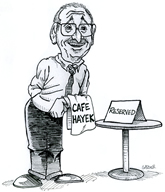Frédéric Bastiat’s Parable of the Broken Window made the point that destruction can increase GDP by stimulating the need for repair. And GDP has another shortcoming: It can’t account for the buying and selling we don’t engage in because of the disincentive effects of bad policy. When you run out to put a down payment on a new car, it shows up in the GDP numbers. When you decide to squeeze another year or two out of the old jalopy, no entry is recorded.
Mr. Trump is tacking so fast on his tariff negotiations, throwing out new rates and new threats every week—sometimes every day—that no one can say for sure where it will all eventually settle. No company with any exposure to overseas markets can plan under such circumstances. In what dataset can we find an accounting of the domestic investments that aren’t being made because of the uncertainty surrounding Mr. Trump’s mood swings? The companies that aren’t expanding because they can’t be sure if their supply lines will hold? The employees who aren’t being hired because of the trickle-down effects on Main Street of a global trade war?
Bastiat (1801-50) taught us the importance of considering all the economic activity that doesn’t come to pass because of a particular policy. Henry Hazlitt (1894-1993) updated that wisdom for American readers a century later: “The bad economist only sees what immediately strikes the eye; the good economist also looks beyond.”
The MAGA right will say that shaving a few points off GDP is worth it in the long run if it means we can reshore certain key industries or send China a message about our national resolve. Sure, there will be some short-term pain. Sure, some sacrifices will need to be made.
No nation was ever made more secure by limiting its own potential. No society ever thrived by taking the wind out of its own sails. Short-run considerations are of course important, but be wary of those who declare the race over before the first turn.
Amity Shlaes writes insightfully about trade, protectionism, and national security. Four slices:
But the truth is we know little about the next war. And even less about the war that comes after that. That’s why building up a grand defense can’t suffice. Hitler’s panzers rolled right around the Maginot Line, through Belgium.
What we do know is that a strong American economy is its own Golden Dome. The more economically formidable the United States, the less likely others are to assail us. Wars can be waiting games, and stronger economies have the resources to outwait the other side. But what makes an economy strongest?
The answer, so counterintuitive to the collective war brain, is that the strongest economy is less fortress than playground. An economic playground that lures all kinds of innovators, especially individuals and small companies, can yield great benefits for the U.S., whether in immediate conflict or wars far in the future.
Why a playground? Because in peace as in war, the government is a rotten guesser. The business bets that a peacetime government places don’t yield optimal growth — green technology being just one example. Stunning growth comes from the ideas of outsiders, the lesser-knowns. Rather than target certain sectors and try to engineer results, therefore, the government should aim to make overall conditions more inviting.
What’s more, war’s course is often turned by what some call a “technological surprise,” an innovation so unexpected that it flummoxes the enemy. Often enough, the surprise comes from an outside innovator. Back in 2014, when war between Ukraine and Russia broke out, no one expected that Elon Musk and Starlink would be playing such a role in the conflict today.
…..
To welcome innovators, Harding and Mellon quickly addressed the tax that most constrains new businesses: the capital gains tax. At the time, the tax code treated capital gains the same as income, which meant investors could pay up to 73 percent on, say, profit from the sale of a stock. In 1921, Congress, at the urging of Harding and Mellon, cut the capital gains tax to 12.5 percent.
When Harding passed away in 1923, his successor, Calvin Coolidge, vowed to continue Harding’s pro-innovator campaign. Coolidge and Mellon led lawmakers in driving tax rates down yet further, so that by 1926 the top marginal rate on income stood at 25 percent, low by world standards. Under Coolidge, the regulators at the Federal Trade Commission went quiet. So did the Justice Department, the source of antitrust forays by Theodore Roosevelt, William Howard Taft, and Woodrow Wilson.
The result of the Harding-Mellon-Coolidge restraint was average real growth of greater than 4 percent. That growth brought — attention, Representative Thomas Massie — sufficient revenue to pay down a third of federal debt. Progressives complained that the Roaring Twenties were creating too many millionaires. The public didn’t much care. For wages rose, especially for skilled workers; joblessness stayed low; and consumer goods from autos to washing machines were now priced within the reach of even the working class. Productivity gains meant the standard workweek moved from six days to five. It’s hard to quibble when you’re given a gift called “Saturday.”
…..
That last surprise technology won our Navy the Battle of Midway. The Japanese might have beat us on radar, but Japan’s authorities and economy, both all fortress, showed scant interest in the Japanese professor who did the best work on antennae for long-wave airborne searches, Hidetsugu Yagi. The Japanese military woke up only when they captured a British searchlight-control apparatus in Singapore and discovered its antenna was a “Yagi.”
…..
Still, the takeaways are clear. Subsidies for old weapons, the Golden Dome, and other carefully crafted programs will perhaps prove useful in the next war. What may matter more are the corporate tax cuts of President Trump’s 2017 law. Sustaining lower tax rates, as the new tax law does, will also help. A deep cut in the capital-gains tax rate could do yet more — politically impossible as such a proposal may sound. So would stronger intellectual property laws and less regulation. For the technological surprise of the next conflict, or the conflict after that, will likely come from someone we don’t yet know.
Speaking of national security, Brandan Buck reviews Andrew Preston’s new book on its history in America. Three slices:
The idea of “national security” is so ubiquitous that it is hard to imagine an American political culture without it. But as the Cambridge historian Andrew Preston shows in Total Defense: The New Deal and the Invention of National Security, the concept and its universal usage have not always been with us. They have a history firmly rooted in New Deal liberalism, its anxieties about economic insecurity at home, and its fears of illiberal forces abroad.
Despite the framing suggested by the subtitle, this well-argued and often provocative book stretches from the 19th century through the early Cold War. Preston’s purpose, he writes, is “to find the source of the idea, now axiomatic, that the security of the United States often had little to do with the immediate safety of the continental United States itself.” He argues that the modern ideology of national security, one where security is unmoored from strict dictates of Americans’ physical safety from immediate danger, was primarily an elite project. That elite pushed, cajoled, and scared a nation that once prided itself on having the luxury of distance into seeing its interests as global. America, the new thinking held, belongs at the center of a “horizonless world.”
…..
But under President Franklin Delano Roosevelt, a new national security ethos buried free security for good. Preston argues that the Roosevelt administration used World War I as a “model of efficient, centralized planning in a crisis environment”; the country’s leaders adopted an atmosphere of wartime rhetoric that cast the Depression as a threat worthy of aggressive action. Preston argues that the New Dealers’ domestic logic—the idea of using planning to mitigate risk—provided the ideological lattice upon which the idea of national security was grafted. With the coming of total war in Europe, a crisis exacerbated by technological change, Roosevelt and his advisers asserted that the era of free security, like the supposed era of unconstrained capitalism, was now history.
…..
Preston’s book joins a growing body of scholarship that shifts the genesis of the national security state and its related foreign policy from the early Cold War to the FDR administration. Such scholarship has often argued that the formation of the national security state was not merely reactive but lay within the New Deal, its assumptions about modernity, and its implications for liberalism. While earlier works such as James T. Sparrow’s Warfare State focus on the domestic economy and Ira Katznelson’s Fear Itself on domestic politics, Preston centers his book on how an elite progressive idea of national security became a bipartisan and ubiquitous social norm that spanned the challenges of fascism, communism, and beyond.
Ramesh Ponnuru decries Trump’s tariffs. A slice:
Tariffs obviously raise some prices. That’s how they’re supposed to work. Protectionists seek to change patterns of consumption and production by altering prices. Tariffs make imported steel more expensive, so U.S. consumers (including companies that use steel) buy more domestically produced steel. U.S. steelmakers can then increase their prices, too, drawing more investment
But raising some prices need not mean raising the overall price level. Maybe consumers will spend more on products with steel in them and less on everything else, with prices going down in other sectors. Or maybe a monetary contraction will pull prices down. That’s what happened in the early years of the Great Depression, when a spike in tariffs happened alongside deflation..
The Bureau of Labor Statistics, a unit of the Labor Department, revised its estimates for May and June payrolls sharply downward, by more than 250,000 jobs, and estimated that the economy added only 73,000 jobs in July, well below analysts’ expectations. Virtually all these new jobs came from health care and social services. The numbers contain no sign of the manufacturing boom that President Donald Trump has promised.
This is not the sort of jobs report any president wants to see; it’s the kind that portends falling approval ratings and party losses at the next election. So Trump took immediate, decisive action: He hopped on Truth Social and announced that he would fire Erika McEntarfer, the commissioner of the Bureau of Labor Statistics.
This move was so boneheaded, William Beach, who served as bureau commissioner during the first Trump administration, called it “totally groundless” and “a dangerous precedent” that “undermines the statistical mission of the Bureau.”
Even Heather Mac Donald argues that “Trump’s science reform veers off course.” A slice:
Other battles are more worthy of attention. Congressional Republicans should provide the White House with an unambiguous charter for its reform efforts. Congress should strip all identity-politics language from NSF budgetary authorizations by rejecting the notion that researchers must justify their work on nonscientific grounds. Lawmakers should also extricate the NSF from teacher training and education research. Congress and the administration could treat scientists like adults again by cutting red tape and restoring discretion to project managers and researchers.
The White House has started a long overdue overhaul of science and academia, unleashing end-of-times prophesying from those intertwined establishments. But federal science funding shouldn’t go to social or economic goals, “equity” or any other ideology. Rather, its aim should be to unleash human genius in its confrontation with natural mystery.



